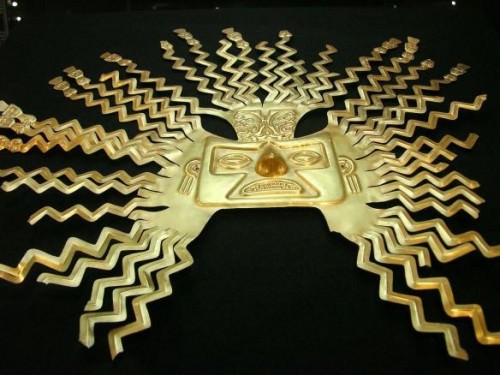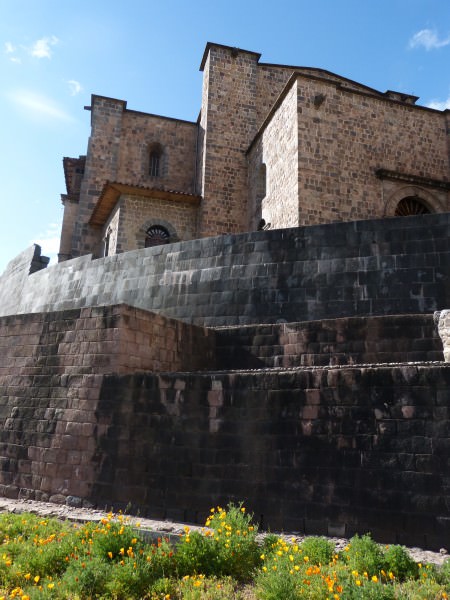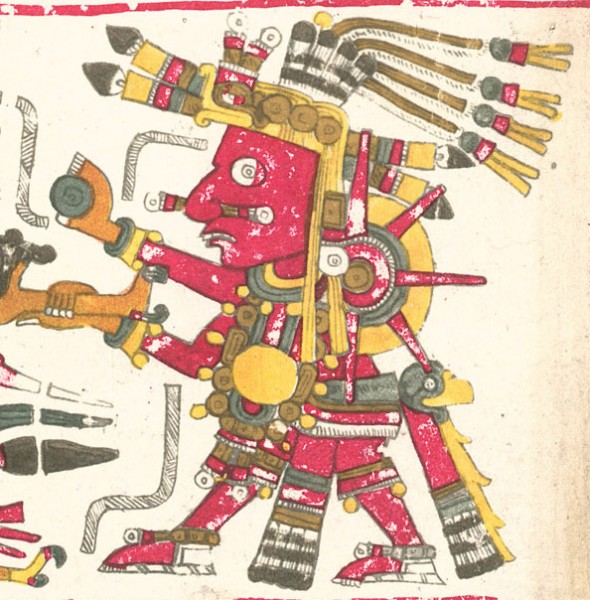Coricancha › Tonatiuh » Ancient origins
Articles and Definitions › Contents
- Coricancha › Ancient History
- Tonatiuh › Antique Origins
Ancient civilizations › Historical and archaeological sites
Coricancha › Ancient History
Definition and Origins

The religious complex of Coricancha ( Qorikancha ) in the Inca capital at Cuzco contained the Temple of the Sun which was not only the most sacred site or huaca in the Inca religion but was considered the very centre of the Inca world. The site was also known as the Golden Enclosure and was dedicated to the highest gods in the Inca pantheon such as the Creator god Viracocha, the moon goddess Quilla and especially to Inti, the god of the sun. Little remains today except some sections of its fine stone walls which hint at the site's once massive size and the legendary stories which tell of the enormous quantity of gold used to decorate the temples and its golden garden.
LAYOUT & ARCHITECTURE
The construction of the complex is commonly attributed to Pachacuti Inca Yupanqui, the 9th Inca ruler (1438-1471 CE) who also embarked on a general rebuilding programme in the capital. Despite excavations, though, the exact chronology of the site is not clear. In Inca mythology the first Inca leader Manco Capac (Manqo Qhapaq) built a temple at the site in the early 12th century CE and archaeology does show evidence of pre- empire structures.
The lay-out of the site, as seen from above, actually resembled a sun with rays shining out in all directions. These were the sacred ceque ( zeq'e ) lines - physical and cosmic roads - of which there were 41 which led to an impressive 328 sacred sites.Cuzco itself was deliberately laid out to represent a jaguar and Coricancha was located at the tail. In typical Inca symmetry the second most important sacred site in the city - Sacsahuaman - was located at the head. Coricancha was also built where the city's two great rivers of Huantanay and Tullamayo met.
THE DOORS WERE COVERED IN GOLD SHEETS, AS WERE THE INTERIORS AND EXTERIORS OF THE VARIOUS TEMPLES AND THE INNER SIDE OF THE PERIMETER WALL WAS EVEN SAID TO HAVE BEEN STUDDED WITH EMERALDS.
Built using the fine masonry skills for which the Inca have rightly become famous, the massive walls of the complex were built from large stone blocks finely cut and fitted together without mortar. The large curved western wall was particularly noted for its form and elegant, regular masonry. Most walls also leaned slightly inwards as they rose in height, a typical feature of Inca architecture. Many trapezoid doorways and windows allowed access and light to enter the interior spaces and a broad band of gold was added mid-way height around the walls. The interior buildings were of one storey and had thatched roofs. The doors were also covered in gold sheets, as were the interiors and exteriors of the various temples and the inner side of the perimeter wall was even said to have been studded with emeralds.
TEMPLE OF THE SUN
The most important temple in the precinct was the Temple of the Sun, dedicated to the sun god Inti. The interior and exterior walls of the temple, situated in the northern corner of the complex, were covered in gold - considered the sweat of the sun - which was beaten into sheet plates. There were, reportedly, 700 of these half-metre square sheets, each weighing 2 kg.
Inside the temple, besides golden artefacts relevant to the god's worship, was a gold statue of Inti encrusted with jewels. The statue represented Inti as a small seated boy called Punchao (Day or Midday Sun). From his head and shoulders the sun's rays shone, he wore a royal headband and had snakes and lions coming out of his body. The stomach of the statue was hollow and used to store the ashes of the vital organs of previous Inca rulers. Everyday this statue was brought out into the open air and returned to the shrine each night. Another important representation of the god - a giant mask with zig-zag rays bursting from the head - was hung from the wall of a specially dedicated chamber within the temple.

Inca Gold Sun Mask
The garden of the temple was a wonderfully conceived homage to Inti. Just as land - sometimes even entire regions - were dedicated to the god, so too, this garden was constructed in honour of the great sun god Inti. Everything in it was made of gold and silver. A large field of corn and life-size models of shepherds, llamas, jaguars, guinea pigs, monkeys, birds and even butterflies and insects were all crafted in precious metal. And if that wasn't enough to please Inti there were also a large number of gold and silver jars all encrusted with precious stones. All that survives of these wonders are a few golden corn stalks, a convincing, if silent, testimony to the lost treasures of Coricancha.
OTHER TEMPLES
Five other temples or wasi were placed around the main square courtyard of Coricancha. In order of hierarchy, one temple was dedicated to the creator god Viracocha (more or less equal to Inti), one to Quilla the goddess of the moon, one to Venusor Chaska-Qoylor, one to the god of thunder Illapa, and finally one for Cuichu the rainbow god. Just as Inti's temple was covered in gold, Quilla's temple was covered in silver, a metal thought to be the tears of the moon. Each wasi contained a cult statue of that particular god and precious art and religious objects connected to them.
There was also a dedicated space for the mummified remains of former Inca emperors and their wives, known as mallquis.These were brought out of storage during special ceremonies such as those celebrating the solstices. Offerings were made to these mummies dressed in fine clothes, and the great achievements they had made during their reigns were read out for all to hear. There were also living quarters for priests and priestesses and still other rooms of the complex were used as art and religious treasuries stuffed with artefacts taken from conquered peoples. These may well have been kept in order to guarantee compliance to Inca rule, just as conquered rulers were sometimes held hostage at Cuzco for periods of the year. Yet another interesting feature of the site was an underground channel through which sacred water flowed to the surrounding squares outside the complex.

Coricancha
Other important functions of Coricancha included the taking of astronomical observations, especially of the Milky Way ( Mayu ).There was, for example, a pair of towers which marked the Summer solstice and sightings were taken from the sacred ushnustone against man-made and natural landmarks on the horizon to track the sun. Sacrificial victims ( capacochas ) were also made ready for their great moment in the precinct's courtyard and then marched along the ceque lines to be sacrificed in the various provinces in honour of Inti and his living incarnation, the Inca emperor.
LATER HISTORY
The rather plain entrance doorway of the complex survives today with its typical double jamb, as do sections of the outer walls and some interior walls. The Christian monastery of Santo Domingo was built on top of the complex, no doubt, in a deliberate attempt to signify that one religion had been replaced by another. Most of the gold from the site was, of course, melted into ingots and taken for the Spanish Crown. The star piece, the golden statue of Inti, was taken to a place of safety when the Spanish arrived but it seems that they did eventually find it thirty years later in 1572 CE but it disappeared without trace, probably melted down like so many other Inca artefacts.
Tonatiuh › Antique Origins
Definition and Origins

Tonatiuh, 'Turquoise Lord,' was the 5th and present sun in the Aztec view of the cosmos and the fierce sun god of several other Postclassic Mesoamerican cultures, including the Toltecs. It was thought that only the regular offering of hearts from sacrificial victims would nourish Tonatiuh so that he had the strength to reign supreme in the skies and battle each night the forces of darkness. For many, the sun god is the central figure on the Sun Stone, perhaps the most famous of all Aztec artpieces, where his tongue appears as a sacrificial blade thirsty for blood.
NAMES & ASSOCIATIONS
The idea in Mesoamerica of a sun god with martial qualities goes back to the Classic Maya figure of K'inich Ajaw. For the Zapotec civilization (500 BCE - 900 CE) in the southern highlands of central Mexico in the Valley of Oaxaca, Tonatiuh was Copijcha (aka Cocicho). The Toltec civilization, which flourished in central Mexico between the 10th and mid-12th century CE, closely associated Tonatiuh with Quetzalcoatl, the feathered serpent god, and his manifestation as the morning star aspect of the planet Venus.
To the Aztecs of ancient Mexico (c. 1345-1521 CE) Tonatiuh was also known as Cuauhtlehuanitl ('Ascending eagle') and Cuauhtemoc ('Descending eagle'). His calendar name was Nahui ollin, 4 Motion, he was patron god of the 19th day Quiahuitl(rain), and 4th of the 13 Aztec Lords of the Day with an associated 'bird' sign of the quail. The sun was associated with goldand, for the Mixtec, made of turquoise, hence Tonatiuh is sometimes known as 'Turquoise Lord' (as, confusingly, is Xiuhtecuhtli, the Aztec god of Fire). Tonatiuh was a fierce and warlike god and it is suggestive that the Aztecs called the cruel and ruthless conquistador Pedro de Alvarado none other than Tonatiuh.
SACRIFICES ENSURED TONATIUH'S SUCCESSFUL RETURN & VICTORY EACH NIGHT AGAINST THE FORCES OF DARKNESS.
THE AZTEC CREATION MYTH
The Aztecs believed that the cosmos had already gone through four stages, each with its own sun and beings. The present era for the Aztecs was that of the 5th and final sun, Tonatiuh. The god had been born from the sacrifice of Nanahuatzin who threw himself into a fire at Teotihuacan and thus became the new sun. There was an immediate problem that Tonatiuh could or would not set himself in motion across the sky without a blood sacrifice. Now stepped in Tlahuizcalpantecuhtli, for the Aztecs the planet Venus as the menacing morning star. He angrily threw his atl-atl dart at Tonatiuh in order to set him on his orbit, but the sun retaliated by throwing a dart right back. This missile hit Tlahuizcalpantecuhtli right in the forehead, instantly transforming him into stone and the god Itztlacoliuhqui, a deity associated with ice and cold. The rest of the gods realised that only a sacrifice would set the sun in motion and so Quetzalcoatl removed their hearts for that purpose. The offering worked and Tonatiuh was on his way.

Tonatiuh
Tlahuizcalpantecuhtli had not left the scene permanently, though, and every 584 days he rises from the eastern sea to do battle with Tonatiuh once again. For this reason, Tonatiuh had to be strengthened via the sacrifice of humans so that he could feast on their hearts, just as he had first been nourished by the hearts of the gods. It was imagined that the sun was swallowed each night by the earth-fertility goddess, Tlaltecuhtli, and then regurgitated by the toad-like monster the following morning.Sacrifices ensured his successful return and victory each night against her and the forces of darkness.
Warriors were closely associated with Tonatiuh because it was their duty to ensure a steady supply of sacrificial victims for him. The spirits of dead warriors, too, were conducted to the next life by Tonatiuh. In addition, given the sun's vital role in ensuring the well-being of the cosmos and the Aztec ruler's position as chief warrior, Tonatiuh had his own sacrificial altar during coronation ceremonies. In times of great strife such as famine, droughts, and war, Tonatiuh could receive the huge number of bloody sacrifices that the Aztecs have become infamous forever since.
REPRESENTATION IN ART
In art, Tonatiuh is most often represented as a symbolic sun disk which was carved onto monuments and large-scale sculpture. An impersonator of the god wore such a disk on his back during sacrificial ceremonies held in his honour, and sometimes the god himself is portrayed in sculpture as a squatting man with a large disk on his back. An example of this latter type is currently on display in the Museum fur Volkerkunde, Basel, Switzerland. On the disk is the symbol for earthquakes ( ollin ) which the Aztecs believed would be the source of the destruction of the 5th cosmos.
The earliest depictions of Tonatiuh come from the art of the Toltec civilization at the Postclassic site of Ixtapantongo and at Chichen Itza. When appearing in colour, such as in Postclassic codices, Tonatiuh is usually red, with an eagle feather headdress and a rayed sun disk. Finally, many scholars see the central face on the celebrated Sun Stone (aka Calendar stone ), found at the base of the Templo Mayor at the Aztec capital of Tenochtitlan, as being that of Tonatiuh (for others it is the night sun Yohualtecuhtli or Tlaltecuhtli). The basalt stone, dating to c. 1427 CE, measures 3.58 metres in diameter, is 98 centimetres thick, and weighs 25 tons. It represents not a calendar but a solar disk depicting the five worlds of the Aztec cosmos and may have been used as an altar upon which to sacrifice victims. It is on permanent display at the National Museum of Anthropology in Mexico City.
LICENSE:
Article based on information obtained from these sources:with permission from the Website Ancient History Encyclopedia
Content is available under License Creative Commons: Attribution-NonCommercial-ShareAlike 3.0 Unported. CC-BY-NC-SA License